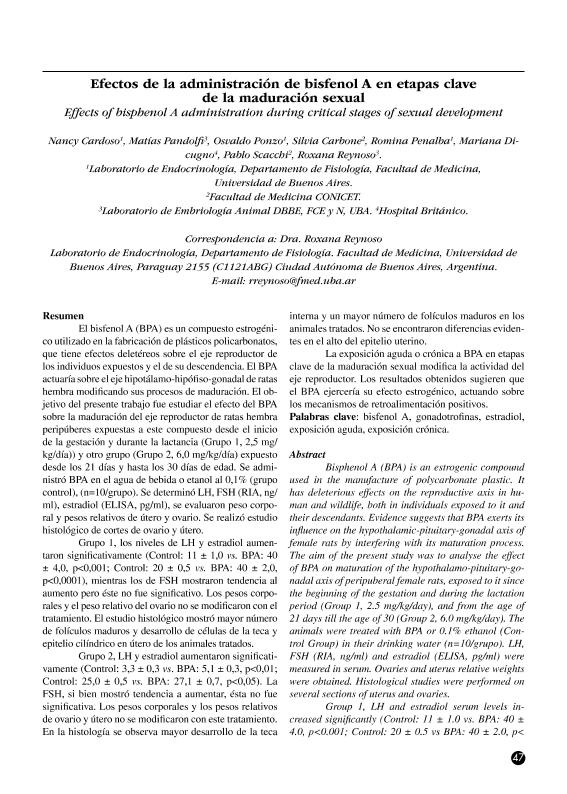Artículo
El bisfenol A (BPA) es un compuesto estrogénico utilizado en la fabricación de plásticos policarbonatos, que tiene efectos deletéreos sobre el eje reproductor de los individuos expuestos y el de su descendencia. El BPA actuaría sobre el eje hipotálamo-hipófiso-gonadal de ratas hembra modificando sus procesos de maduración. El objetivo del presente trabajo fue estudiar el efecto del BPA sobre la maduración del eje reproductor de ratas hembra peripúberes expuestas a este compuesto desde el inicio de la gestación y durante la lactancia (Grupo 1, 2,5 mg/kg/día)) y otro grupo (Grupo 2, 6,0 mg/kg/día) expuesto desde los 21 días y hasta los 30 días de edad. Se administró BPA en el agua de bebida o etanol al 0,1% (grupo control), (n=10/grupo). Se determinó LH, FSH (RIA, ng/ml), estradiol (ELISA, pg/ml), se evaluaron peso corporal y pesos relativos de útero y ovario. Se realizó estudio histológico de cortes de ovario y útero. Grupo 1, los niveles de LH y estradiol aumentaron significativamente (Control: 11 ± 1,0 vs. BPA: 40 ± 4,0, p<0,001; Control: 20 ± 0,5 vs. BPA: 40 ± 2,0, p<0,0001), mientras los de FSH mostraron tendencia al aumento pero éste no fue significativo. Los pesos corporales y el peso relativo del ovario no se modificaron con el tratamiento. El estudio histológico mostró mayor número de folículos maduros y desarrollo de células de la teca y epitelio cilíndrico en útero de los animales tratados. Grupo 2, LH y estradiol aumentaron significativamente (Control: 3,3 ± 0,3 vs. BPA: 5,1 ± 0,3, p<0,01; Control: 25,0 ± 0,5 vs. BPA: 27,1 ± 0,7, p<0,05). La FSH, si bien mostró tendencia a aumentar, ésta no fue significativa. Los pesos corporales y los pesos relativos de ovario y útero no se modificaron con este tratamiento. En la histología se observa mayor desarrollo de la teca interna y un mayor número de folículos maduros en los animales tratados. No se encontraron diferencias evidentes en el alto del epitelio uterino. La exposición aguda o crónica a BPA en etapas clave de la maduración sexual modifica la actividad del eje reproductor. Los resultados obtenidos sugieren que el BPA ejercería su efecto estrogénico, actuando sobre los mecanismos de retroalimentación positivos. Bisphenol A (BPA) is an estrogenic compound used in the manufacture of polycarbonate plastic. It has deleterious effects on the reproductive axis in human and wildlife, both in individuals exposed to it and their descendants. Evidence suggests that BPA exerts its influence on the hypothalamic-pituitary-gonadal axis of female rats by interfering with its maturation process. The aim of the present study was to analyse the effect of BPA on maturation of the hypothalamo-pituitary-gonadal axis of peripuberal female rats, exposed to it since the beginning of the gestation and during the lactation period (Group 1, 2.5 mg/kg/day), and from the age of 21 days till the age of 30 (Group 2, 6.0 mg/kg/day). The animals were treated with BPA or 0.1% ethanol (Control Group) in their drinking water (n=10/grupo). LH, FSH (RIA, ng/ml) and estradiol (ELISA, pg/ml) were measured in serum. Ovaries and uterus relative weights were obtained. Histological studies were performed on several sections of uterus and ovaries. Group 1, LH and estradiol serum levels increased significantly (Control: 11 ± 1.0 vs. BPA: 40 ± 4.0, p<0.001; Control: 20 ± 0.5 vs BPA: 40 ± 2.0, p<0.0001). FSH levels showed an increasing trend as well, but this was not statistically significant. Corporal weights and ovaries relative weights were not modified by treatment. Histological studies showed an increase in the total number of mature follicles, and development of the theca cells and ovarian stroma, in animals exposed to BPA. Group 2, LH and estradiol serum levels increased significantly (Control: 3.3 ± 0.3 vs. BPA: 5.1 ± 0.3, p<0.01; Control: 25.0 ± 0.5 vs. BPA: 27.1 ± 0.7, p<0.05). Although FSH levels exhibited an increasing trend, this did not reach statistical significance. Corporal weights and ovaries and uterus relative weights were not modified by treatment. Histological studies revealed major development of the internal theca, and an increase in the number of mature follicles, in those animals under treatment. No significant differences were found in the height of the epithelium of the uterus. Acute or chronic exposure to BPA during critical stages of sexual development modifies the activity of the reproductive axis. The results obtained suggest that BPA may exert its estrogenic effect, acting on the positive feedback mechanism.
Efectos de la administración de bisfenol A en etapas clave de la maduración sexual
Título:
Effects of bisphenol A administration during critical stages of sexual development
Cardoso, Nancy Patricia ; Pandolfi, Matias
; Pandolfi, Matias ; Ponzo, Osvaldo; Carbone, Silvia Elena
; Ponzo, Osvaldo; Carbone, Silvia Elena ; Peñalba, Romina; Dicugno. Mariana; Scacchi, Pablo
; Peñalba, Romina; Dicugno. Mariana; Scacchi, Pablo ; Reynoso, Roxana
; Reynoso, Roxana
 ; Pandolfi, Matias
; Pandolfi, Matias ; Ponzo, Osvaldo; Carbone, Silvia Elena
; Ponzo, Osvaldo; Carbone, Silvia Elena ; Peñalba, Romina; Dicugno. Mariana; Scacchi, Pablo
; Peñalba, Romina; Dicugno. Mariana; Scacchi, Pablo ; Reynoso, Roxana
; Reynoso, Roxana
Fecha de publicación:
11/2010
Editorial:
Sociedad Argentina de Endocrinología Ginecológica y Reproductiva
Revista:
SAEGRE
ISSN:
1669-9106
Idioma:
Español
Tipo de recurso:
Artículo publicado
Clasificación temática:
Resumen
Archivos asociados
Licencia
Identificadores
Colecciones
Articulos(OCA HOUSSAY)
Articulos de OFICINA DE COORDINACION ADMINISTRATIVA HOUSSAY
Articulos de OFICINA DE COORDINACION ADMINISTRATIVA HOUSSAY
Citación
Cardoso, Nancy Patricia; Pandolfi, Matias; Ponzo, Osvaldo; Carbone, Silvia Elena; Peñalba, Romina; et al.; Efectos de la administración de bisfenol A en etapas clave de la maduración sexual; Sociedad Argentina de Endocrinología Ginecológica y Reproductiva; SAEGRE; 17; 3; 11-2010; 47-55
Compartir



